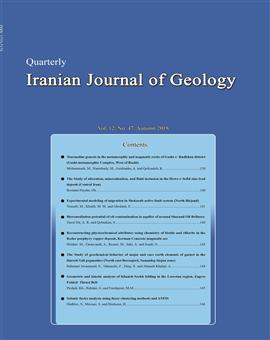-
-
List of Articles
-
Open Access Article
1 - Tourmaline genesis in the metamorphic and magmatic rocks of Gasht-e- Rudkhan district (Gasht metamorphic Complex, West of Rasht)
Maryam Mohammadi Abbas Asiabanha Kazem Gholizadeh -
Open Access Article
2 - The Study of alteration, mineralization, and fluid inclusion in the Howz-e-Sefid zinc-lead deposit (Central Iran)
-
Open Access Article
3 - The Study of alteration, mineralization, and fluid inclusion in the Howz-e-Sefid zinc-lead deposit (Central Iran)
Mansor Adelpour godratollah Rostami Paydar -
Open Access Article
4 - Experimental modeling of migration in Shekarab active fault system (North Birjand)
Mehdi Yosefi Mohammad Mahdi Khatib Ebrahim Gholami -
Open Access Article
5 - Bioremediation potential of oil-contamination in aquifer of around Shazand Oil Refinery
Abdolreza Vaezi Sanaz Qobadian -
Open Access Article
6 - Reconstructing physicochemical attributes using chemistry of biotite and chlorite in the Keder porphyry copper deposit, Kerman Cenozoic magmatic arc
Majid Heydari Alireza Zarasvandi Mohsen Rezaei عادل ساکی Sina Asadi -
Open Access Article
7 - The Study of geochemical behavior of major and rare earth elements of garnet in the Darreh Vali pegmatites (North-east Boroujerd, Sanandaj-Sirjan zone)
-
Open Access Article
8 - The Study of geochemical behavior of major and rare earth elements of garnet in the Darreh Vali pegmatites (North-east Boroujerd, Sanandaj-Sirjan zone)
-
Open Access Article
9 - The Study of geochemical behavior of major and rare earth elements of garnet in the Darreh Vali pegmatites (North-east Boroujerd, Sanandaj-Sirjan zone)
Somaye Rahmani Zahra Tahmasbi Xin Ding Ahmad Ahmadi Khalagi -
Open Access Article
10 - Geometric and kinetic analysis of Khaneh Sorkh folding in the Lorestan region, Zagros Folded– Thrust Belt
-
Open Access Article
11 - Geometric and kinetic analysis of Khaneh Sorkh folding in the Lorestan region, Zagros Folded– Thrust Belt
Khatoon Pirdadi Aziz Rahimi Mohamad Mahdi Farahpour
-
The rights to this website are owned by the Raimag Press Management System.
Copyright © 2017-2026







